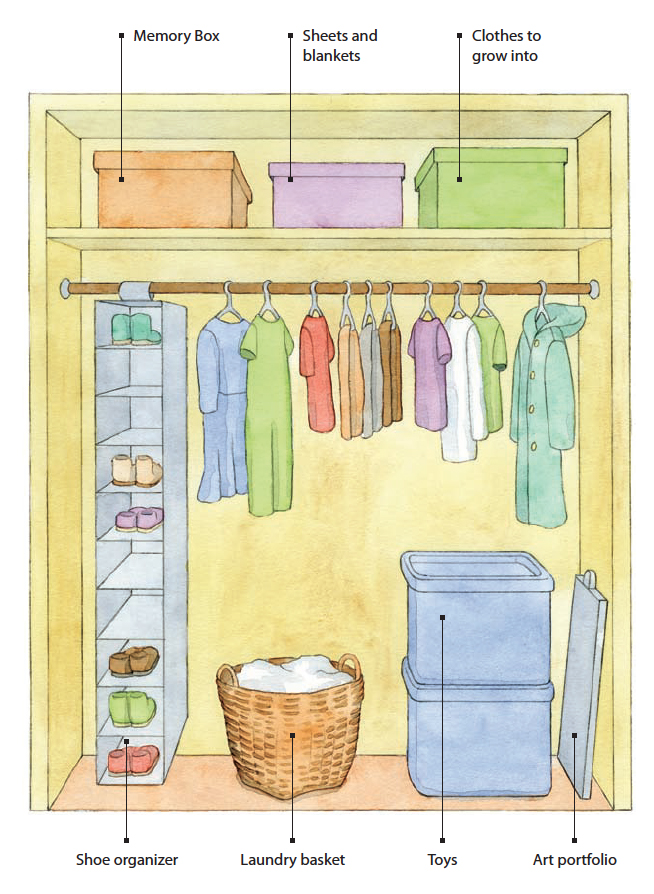

14. Never Enough Closets or Storage
So many moms tell me they don’t have enough closet or storage space. If you have an old home, your closets are probably small and few. You know why? Because they had less stuff in the old days! If you have a newly built home, you may have larger closets and more of them to work with. There are pros and cons to closets in each type of house. While the old houses may have sturdy wooden shelves, closets in the new homes usually have wire racks. Some people have so many closets they can’t decide what to put in them and each closet becomes a catchall.
One of my clients has a small house where she and her husband raised six children. Family gatherings were pretty tight at their house after their children were married and had their own children. They built an additional family room with an average-sized closet in it. The original idea for the closet was to hold the coats for guests because the front hall closet was packed. But the new closet actually became a place to put odds and ends that didn’t have an obvious place in the house. So after a few years, the closet contained shopping bags, the vacuum, games, extra blankets, children’s chairs, and small appliances that were only used a few times a year. There also were bags of miscellaneous papers that had been cleared off the dining room table when company came. One of their daughters bought them a closet organizer to help them out. A year later, it was still in the box, buried under the stuff in their closet. Their son opened the door one day and jokingly said, “See, we put the closet organizer in there but it doesn’t work.”
To truly organize your closets and storage, you’ve got to determine what storage you have, the functions of each closet or area, what needs to be stored, and what if any additional storage options you need. Use your Home Projects Plan book to help tackle this problem.
To assess your storage areas, take a walk through your house. Is there a usable attic, basement, or crawl space? How about a shed or garage? What about shelves or built-in cabinets in your home? Maybe you have an armoire, an old trunk or tall bookcase that you aren’t using. All of these things are potential storage.
After you have cleared out the clutter in your house and decided on the function of each room, it should be easy to decide the function of the closets. The first step in organizing a room is organizing its closet. An organized closet allows you to maximize what you store so you can better arrange what is left out displayed. Remember to keep like things together and limit the function of the closet to two or three categories. For instance, a bedroom closet may hold clothes, shoes, and extra linens. A family room closet may hold games, throw blankets, and candles. A closet in the front entrance may hold outerwear, umbrellas, and backpacks for school. This helps prevent the overloaded and overstuffed closet where everything is shoved in and piled high. Even if your closet is bigger than you need, limit the use of it. There’s nothing wrong with having space to spare!
Absolute of Organizing: Keep like things together.
When we talk about storage, we typically use it for items that we don’t need every day, or large items that can’t be kept in an average room in the house, such as golf clubs, large “outside” toys, gardening tools, the vacuum, holiday decorations, outof-season clothes, memory boxes, and camping gear. You may also have unique things to store like inventory for your business, a collection that you haven’t decided what to do with, or items that you sell online. Write these items down on your list and then treat it like a matching test, drawing lines from the “What needs to be stored” column to the “Storage Area” column. This chart should address the big categories of things you have as well as those odds and ends that don’t seem to fit into any category.
SAMPLE STORAGE CHART:
| STORAGE AREA | CONTENTS |
| Attic |
|
| Cedar closet |
|
| Basement |
|
| Front hall closet |
|
| Linen closet |
|
| Garage |
|
| Kitchen closet |
|
| Shed |
|
When you start reorganizing a closet, you’ve got to take everything out. Use the C.P.R. (Categorize, Purge and Rearrange) process and remember that in this case “purging” may just mean moving something to a different closet. Before you rearrange, take a good look at the space you have. Be sure to use it efficiently before placing any items inside. In some cases you may need to temporarily put a category in a cardboard box or bag until you purchase the container or shelf that you want for your closet.
Now that you’ve decided what’s going into a closet or storage area, consider how to fit it all in so that it’s accessible. There’s always the option of hiring a closet organizer company to come in and custom build shelves and racks. But sometimes it’s just as easy (and less expensive) to work with the shelving you have and make minor changes. Here are some quick tips for efficiently using the space in your closets:
Example Layout of a Child’s Closet

If you simply don’t have enough closets, then consider furniture that has built in storage. Many companies make pieces of furniture that offer additional storage. If you don’t have a front hall closet, you could use a coat rack or a storage bench. If you don’t have a garage, then you can use a shed or basement for storing outdoor equipment.